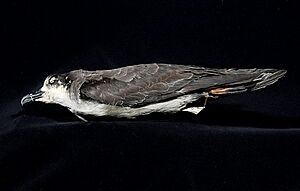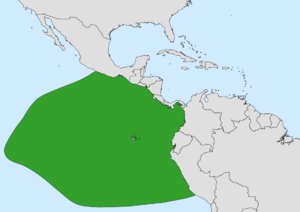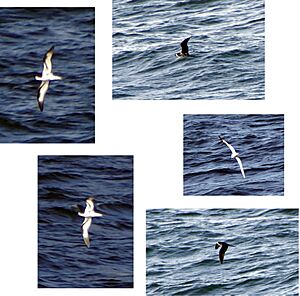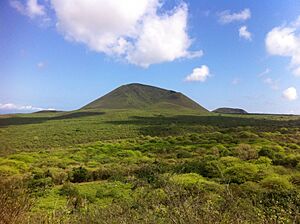Galápagos petrel facts for kids
Quick facts for kids Galápagos petrel |
|
|---|---|
 |
|
| A Galapagos Petrel (Pterodroma phaeopygia) in flight off San Cristobal Island | |
| Conservation status | |
| Scientific classification | |
| Genus: |
Pterodroma
|
| Species: |
phaeopygia
|
The Galápagos petrel (Pterodroma phaeopygia) is a special seabird found only in the Galápagos. Its scientific name, Pterodroma phaeopygia, comes from Ancient Greek words. Pterodroma means "wing runner," and phaeopygia means "dusky rump," describing its dark back. These birds are also called "gadfly petrels" because they fly in a zig-zag way, like a horse-fly.
Locals call them pata pegada, which means "web-footed one." Galápagos petrels live mostly in the ocean, eating small sea creatures and fish. They look so much like Hawaiian petrels that people once thought they were the same species! When it's time to have babies, they fly back to their large groups on the high parts of some Galápagos islands.
Sadly, the number of Galápagos petrels has dropped a lot in the last 60 years. This is mainly because of things people have done. New animals brought by humans, like wild cats, dogs, pigs, and rats, hunt the petrels. Also, land cleared for farms has destroyed their homes and nesting spots. Even with many efforts to protect them, their numbers are still going down. There are only about 6,000 to 15,000 adult birds left. Because of this, they are now listed as "critically endangered" on the IUCN Red List of Threatened Species.
Contents
What the Galápagos Petrel Looks Like
Galápagos petrels look very much like Hawaiian petrels. They are large birds with long wings. Their top side is dark gray, getting darker towards the tips of their wings and tail. They often have a thin white line on each side of their back. A clear black "hood" covers their head and goes down the sides of their neck.
Their face and belly are white. However, the underside of their wings has black edges and a black line that goes across. While Hawaiian petrels always have white foreheads, many Galápagos petrels have small black spots on their faces. Their legs and feet are pink, and the webbing between their toes is black.
Male and female Galápagos petrels look the same, and young birds look just like adults. Sometimes, older petrels might look a bit brown from wear, but their feathers stay mostly the same all year. They usually replace most of their feathers when they are not breeding.
Like all gadfly petrels, Galápagos petrels have short, strong, hooked beaks with sharp edges. They use these beaks to grab, hold, and cut up small prey. A cool thing about these birds is their external tube-like nostrils. This means they have a great sense of smell. They can find their food and even their own nest burrow in the dark!
Even with all these similarities, there are small differences between Galápagos and Hawaiian petrels. Galápagos petrels seem to have longer and narrower beaks. They are also a bit lighter (about 420 grams compared to 434 grams for Hawaiian petrels). But they have longer wings and legs. This means Galápagos petrels fly a little slower but are more agile.
Petrel Family Tree
The Galápagos petrel belongs to a group of 35 gadfly petrel species. They are part of the Procellariidae family and the Procellariiformes order. This is one of the oldest bird groups, and all its members are called "petrels."
The family tree of these birds is quite tricky and often gets updated. It seems that the Procellariidae family separated from other bird groups about 40-50 million years ago in the Southern Hemisphere. Today, they live all over the world. A study of their DNA showed that their closest relatives are divers, penguins, and frigatebirds. Many birds in this family, including the Galápagos petrel, are still not fully understood.
The Galápagos petrel was first described in 1876. Later, it was thought to be the same species as the Hawaiian petrel. But scientists found enough differences in their genes, where they live, and how they look and act. So, they were split into two unique species. The Galápagos petrel became its own species, Pterodroma phaeopygia. Recent studies even found small differences among petrels living on different Galápagos islands!
Where Galápagos Petrels Live
The Galápagos petrel lives only in the Galápagos Islands. They are mostly found in the Galápagos Marine Reserve area. However, studies show that some birds fly far away, sometimes up to 2,000 kilometers south, between January and February. Like other gadfly petrels, these birds live mostly in the open ocean. They are not well-suited for land and only come back to their nests to breed.
Their nesting spots are on five islands: Santiago, Floreana, Isabela, Santa Cruz, and San Cristobal. These islands are all less than 170 kilometers apart. An island can have many nesting groups, each as big as 200 by 300 meters. These groups are usually 300 meters to 5 kilometers apart. Today, Galápagos petrels often nest on small islands offshore. This is because their original homes on the main islands have been damaged or taken over by human activities.
Their nests are usually in high areas, at least 180 meters above the sea. Most nests are in places with thick plants and soft soil, where they can dig deep burrows. But some birds also nest in cracks in volcanic rocks. These ground nests make them easy targets for new animals brought to the islands.
Galápagos Petrel Behavior
Petrels are very good at moving around and can travel long distances for months. It's not fully known what they do when it's not breeding season. Sometimes, petrels gather where there is a lot of food, like around schools of fish.
All petrels are made for ocean life, not so much for land. So, they only spend a lot of time on land during the breeding season. These petrels like to be in groups and form large nesting colonies. Galápagos petrels are very "philopatric." This means they return to the same colony or even the exact same nesting spot with the same partner every year.
Many petrels, including the Galápagos petrel, are "nocturnal," meaning they are active at night. They look for food in the evenings and return to feed their young during the day. They often fly just above the water to catch their prey without diving in. Courtship also happens at night. Petrels are often seen flying high into the sky and moving in strange ways to attract a female.
What Galápagos Petrels Eat
Galápagos petrels are good at finding food that is far from their nests, spread out, and not very nutritious. They mainly eat prey from the deep ocean, like squids, small fish, crabs, and other small sea creatures. They probably catch these at night because that's when some of these animals swim up closer to the surface. Sometimes, larger fish like tuna or porpoises push their prey to the surface. Many of their prey (about 82%) can glow in the dark, which might help the petrels find them at night. Galápagos petrels catch and eat their food while flying.
During nesting season, the parent birds take turns feeding their chick. They bring back partly digested seafood mixed with a lot of high-energy stomach oils. These oils are the main source of energy and water for the young bird. Interestingly, the parents feed the chick the most right after it hatches. The feeding slows down as the chick gets ready to fly. Young birds need a lot of energy to grow and stay warm.
Petrel Sounds
Most gadfly petrels are quiet when they are at sea. But they become very noisy at night when they are near their breeding colony. During courtship, they often make loud, sharp cries. From inside their burrows, they usually make different cooing or growling sounds and some moaning cries.
Studies show that Galápagos petrels call from sunset until dawn on all islands. This happens when they fly around or out of their colonies and during fast chases. Their calls increase the most just before sunrise when the most birds are in the sky. However, one study noted that they were quiet for most of the night and only started calling before sunrise (around 6 AM). The main flight call recorded sounded like “kee-kee-kee-(c)ooo,” with the last note stretched out.
Galápagos petrels mainly use three types of flight calls. There's a short call with 3-5 syllables, which might be for identifying each other. A long call with 6-20 syllables is used in aggressive or defensive situations. And a single-syllable call is for very stressful times. The short and long calls sound different for males and females. Male calls are sweet, but female calls are rougher. Interestingly, birds from different islands also have slightly different calls. Their calls are quite different from those of the Hawaiian petrel.
Life Cycle and Reproduction
Pterodroma species start having babies when they are 5-6 years old. After that, they usually nest once every year. The breeding season happens at different times for different groups of Galápagos petrels. For example, in Santa Cruz and Santiago, it's from March to January. In Isabela, it's from late April to January. In Floreana, it's from October to August. And in San Cristobal, it's from May to October. Even though some seasons overlap, these groups rarely breed with each other. They have likely become different because they stick to their own cycles and stay loyal to their mate and nesting spot.
Adult petrels dig or use old rabbit burrows. They get ready for nesting by making their burrow bigger and gathering dry plants. When a male gadfly petrel finds its lifelong partner, it performs special flights to attract the female. These include fast chases, swoops, and flying high into the sky, all with loud calls. Breeding pairs spend time together in their burrow, preening each other and making calls. After mating, they go back to the sea to eat a lot. This helps them get ready for the time they will lay and sit on their egg. During this time, which lasts about two weeks, each parent will visit the nest briefly so others don't think it's empty.
Each pair lays one white, oval egg. In one study, the eggs weighed about 17% or 20% of the female's body weight. On average, petrel eggs weigh 20-24% of the female's weight. The egg takes about 50 days to hatch. The male and female take turns sitting on the egg for about 12 days each. While one parent is sitting on the egg, it loses about 10-15 grams per day. The other parent is out at sea finding food and doesn't seem to bring food back for its partner. The eggs are rarely left alone. However, both parents might leave the nest to find food if there isn't much around. To help with this, the eggs can handle cold temperatures. But sadly, the black rat (Rattus rattus), an animal brought by humans, often eats the eggs.
When a chick hatches, it has soft, off-white fuzz on its throat and belly. Parents take turns feeding them, and the chicks quickly get very fat, even heavier than their parents. Galápagos petrel chicks can also survive without food for a while, which helps them when food is scarce. Their second layer of fuzz appears after about 10 days, and their feathers grow after 5 weeks. Once the chicks have all their feathers and look like small adults, the parents stop visiting. Overall, not many of their chicks survive to fly.
See also
 In Spanish: Petrel de Galápagos para niños
In Spanish: Petrel de Galápagos para niños







